
Steelie Awards SHORTLIST 2025
Introduction
The Steelie Awards recognise World Steel Association (worldsteel) member companies for their contribution to the steel industry over a one-year period. The selection process for nominations varies between awards. In most cases, nominations are requested through the appropriate membership committee and the worldsteel extranet. Entries are then judged by selected expert panels using agreed performance criteria. The winners of the 2025 Steelie Awards will be announced on Monday 13 October 2025.
Nominations overview
Excellence in low-carbon steel production
ArcelorMittal Torero: Upgrading wood waste into renewable fuel for a greener steel industry: a large-scale demonstration
China Baowu Steel Group Corporation Limited Optimisation of raw materials preparation for ironmaking using third-generation straight grate pelletising technology
EMSTEEL Pioneering low-carbon steel: EMSTEEL’s multi-lever net-zero strategy
JSW Steel Limited Sustainable energy, environment, and decarbonisation (SEED): Accelerating decarbonisation through process efficiency and innovation
Innovation of the year
HYUNDAI Steel Company Development of 1.8GPa grade ultra high-strength hot-stamping material coated with zinc
InfraBuild SENSE 600: Innovative lower-embodied carbon reinforcing steel solution
JFE Steel Corporation Development of advanced sour resistant low-alloy steel for sour gas transportation pipes to contribute stable energy supplies
JFE Steel Corporation J-Lecoa™: World-first integrated levelling control system for fully automated hot strip mill operation
POSCO Ni-free high manganese austenitic steel for cryogenic energy industries
Excellence in sustainability
China Steel Corporation (CSC) Zhong Neng offshore wind farm – Advancing a triple-win for the economy, environment, and society
EMSTEEL EMSTEEL’s Suppliers’ ESG impact mapping and responsible sourcing framework
Gerdau S.A. Gerdau for Rio Grande do Sul: rebuilding the state after a climate tragedy
HBIS Group Co., Ltd. Cross-utilisation of waste water and waste heat forming a new path for the deep integration of EAF process and urban development
HYUNDAI Steel Company Advancement of resource circulation using by-products between different industries
Mobarakeh Steel Company Transforming industrial sludge into strategic value: A sustainability-driven innovation in steelmaking
Ternium Winds of change: Ternium’s first step into renewable energy in Argentina
Excellence in Life Cycle Assessment
ArcleorMittal Life Cycle Assessment being a vital part of AI-driven structural optimisation – Virtual Design Platform (VDP)
CITIC PACIFIC Special Steel Group Co., Ltd. Innovative practices in the development of low-carbon special steel products and brand building based on Life Cycle Assessment
HBIS Group Co., Ltd. “LCA+Life Well-Being Index” Collaborative Evaluation System: Innovating to drive marketing and application of metal decorative products
Jingye Group Research and application of metal powder PCR based on steel joint production
JSW Steel Limited Use of LCA tool to predict the impact of green hydrogen manufacturing process and its injection in gas-based DRI plant under various scenarios
POSCO CEFacT: A system that responds to steel industry decarbonisation standards
Excellence in people
ArcelorMittal Integration of army veterans and supporting the families of fallen employees
China Steel Corporation (CSC) Next-generation operational training and process assistance system through digital twin technology
JSW Steel Limited JSW Steel’s strategic framework for scaling steel technical expertise and innovation
POSCO TL advancement: The key to a sustainable workforce and enduring expertise
Tata Steel Limited Forging futures: Skilled hands, strong minds, safer tomorrow
Ternium From policy to practice: Advancing inclusion across Ternium’s industrial system
Excellence in communications programmes
ArcelorMittal The Paris 2024 Olympic and Paralympic Games
Gerdau S.A. Steel is POP: The steel sunglasses that united Gerdau and Chilli Beans at Rock in Rio
JSW Steel Limited JSW Steel MSME Empowerment
Tenaris Safety in First Person
Tenaris TenarisSiderca 70th anniversary
Ternium “Tomorrow, Santa Cruz” Documentary – Building Futures Through Education
UNESID #WomenOfSteel (#MujeresDeAcero)
United States Steel Corporation I Live Here, Too
Excellence in low-carbon steel production
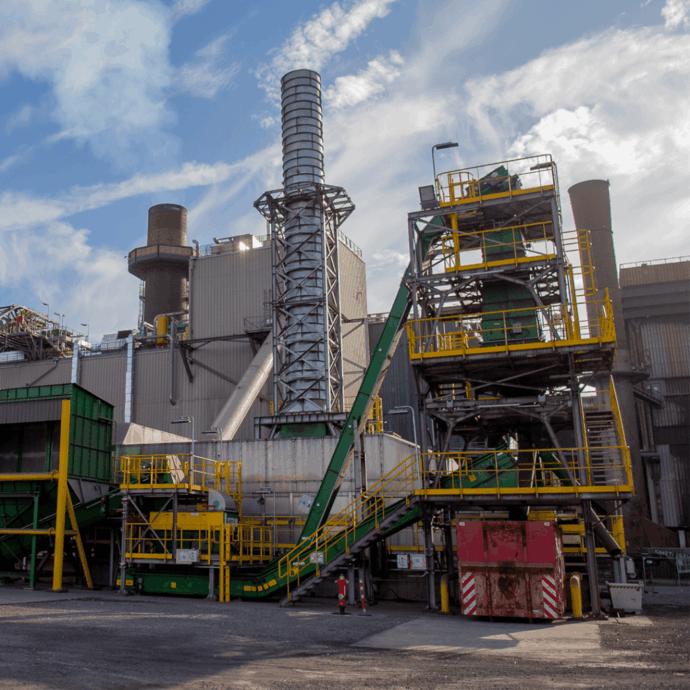
ArcelorMittal
Torero: Upgrading wood waste into renewable fuel for a greener steel industry: a large-scale demonstration
At the heart of the Torero project is a torrefaction reactor that thermochemically converts B-type waste wood to bio-coal. B-type waste wood is industrial or commercial waste wood that has been treated in some way, typically with paints, varnishes, adhesives, or other chemical coatings. The torrefaction process upgrades the B-type waste wood by thermally treating it at moderate temperatures (typically 250–300°C) in the absence of oxygen, which removes moisture and volatile compounds. While reducing the amount of harmful chemicals, this results in a dry, energy-dense material similar to charcoal, which is then pulverised into fine particles to match the specifications of traditional PCI (pulverised coal injection) used in blast furnaces. The process not only diverts waste from incineration or landfill but also closes the carbon loop by reusing carbon already in circulation.
Once processed, the bio-coal is injected directly into the blast furnace, replacing fossil PCI coal and contributing to significant CO2 reductions. The injection process has been validated to work effectively with the torrefied product, and the plant has been operational since December 2023, with the first batches of biocoal produced in September 2023. The current installation includes one reactor capable of processing 87,000 tons of waste wood annually, yielding approximately 37,500 tons of biocoal. The full production capacity is expected to be reached by the end of 2025, with a target carbon content of 65% in the final product.
Looking ahead, ArcelorMittal is exploring the possibility of adding a second Torero line. The business case for the current line is strong: each tonne of biocoal used avoids roughly 3 tonnes of CO2 emissions, and with a high ETS carbon price, the project could be economically viable. As a next step the team is investigating whether other bio-waste types – such as hybrid or SRF pellets – can be torrefied and used in similar applications, potentially expanding the technology to other ArcelorMittal sites across Europe.
As the result of close collaboration involving partners from academia and industry, the Torero project represents a key step in ArcelorMittal’s broader strategy to decarbonise steel production and transition toward a circular economy. By demonstrating that waste can be a resource and that carbon can be recycled, Torero is not only transforming steelmaking , it is redefining what is possible in industrial sustainability.

China Baowu Steel Group Corporation Limited
Optimisation of raw materials preparation for ironmaking using third-generation straight grate pelletising technology
In 2024, China’s crude steel production reached approximately 1 billion tonnes, accounting for 53.3% of global production. Globally, 72% of the total crude steel production is based on the BF-BOF route, while in China, the ratio goes up to 89.8%. It is known that the blast furnace system and raw materials preparation combined are responsible for over 70% of the entire process’s CO2 emissions. As such, developing new technologies for ferrous burden preparation with a lower environmental impact and optimising the blast furnace ferrous burden structure have become central to advancing the green transformation of the BF-BOF route.
Sinosteel Equipment & Engineering Co., Ltd. has developed the world’s latest thirdgeneration straight grate pelletising technology (Version 3.0). Through continuous process innovation and intelligent integration over the years, this technology has evolved into a globally leading low-carbon pellet production system. Numerous technical challenges, especially production of basic pellets with medium-to-high silica contents and efficient heat recovery of flue gas, have been overcome. Successful blast furnace trials with a high ratio of the resulting pellets were carried out with satisfying results.
The developed pelletsing technology enables highly efficient low-carbon pellets using difficult-to-process iron ores exclusively sourced from China. The total energy consumption of third-generation technology converting ore concentrate to pellets is ~0.4102 GJ/t. The energy savings for the agglomeration step translate into a reduction in CO2 emissions of 70%. Furthermore, compared with conventional straight grate technology, the third-generation technology reduces CO2 emissions by an additional 20- 25%.
The substitution of sinter with pellets in blast furnace smelting, based on industry live production data, results in a reduction in coke rate by 20 kg/tHM and lowers CO2 emissions by 0.25 t CO2/tHM, equivalent to a 20-25% reduction in CO2 emissions.
The developed technology is recognised not only as China’s first fully proprietary straight grate pelletising system, but is also considered internationally leading because of its significant decarbonisation potential and high level of intelligence. It provides the global steel industry with a full-chain low-carbon solution, from technology R&D to engineering implementation.

EMSTEEL
Pioneering low-carbon steel: EMSTEEL’s multi-lever net-zero strategy
A defining milestone in EMSTEEL’s Net-Zero Decarbonisation Strategy was the launch of the region’s first green hydrogen steel pilot in 2024, developed in partnership with Masdar. Green hydrogen, produced via PEM electrolysis using renewable electricity, is injected into EMSTEEL’s direct reduced iron (DRI) plant to partially displace natural gas, directly reducing scope 1 emissions. This breakthrough has catalysed offtake partnerships with Aldar and Modon—making them the first UAE developers to use hydrogen-based steel in landmark projects, including the country’s first net-zero carbon mosque.
EMSTEEL has operated a carbon capture utilisation and storage (CCUS) facility since 2016, in collaboration with ADNOC and Al Reyadah. While the technology itself was already established, improved operational alignment and efficiency in 2024 enabled the capture of over 500,000 tonnes of CO2, covering 22% of Scope 1 emissions from steelmaking— representing one of the highest industrial CO2 capture rates in the region.
Progress on clean energy adoption has also been substantial. In 2024, 86% of the electricity used in EMSTEEL’s steel operations was sourced from clean and renewable sources, including I-RECs with a plan of a 31.5 MWp rooftop solar project in partnership with Yellow Door Energy—significantly reducing Scope 2 emissions.
To further lower direct emissions, EMSTEEL is piloting the electrification of gas heating in the DRI process through collaboration with Danieli, using e-PGH (electrical process gas heater) technology to replace fossil combustion with renewable electricity. Energy performance is optimised through ISO 50001-certified energy efficiency programmes, delivering continuous improvements in operational consumption. In parallel, increasing the share of recycled steel scrap in production is helping reduce reliance on virgin iron ore and lowering upstream and process-related emissions.
By 2024, EMSTEEL achieved a 28% reduction in GHG emissions intensity compared to 2019, reaching 0.67 tCO2e per tonne of steel. Seven third-party verified Environmental Product Declarations (EPDs) were also completed, enabling low-carbon procurement and CBAM-compliant exports.

JSW Steel Limited
Sustainable energy, environment, and decarbonisation (SEED): Accelerating decarbonisation through process efficiency and innovation
In October 2024, JSW Steel published its inaugural Climate Action Report. This report formalized our commitment to two primary climate goals that are startegically structured across two distinct phases: first, in Phase 1, we aim to reduce CO2 emissions intensity by 42%; and second, in Phase 2, we seek to achieve net carbon neutrality across all operations under our direct control by 2050.
Launched in 2022 at our largest integrated steel plant (ISP) in Vijayanagar, Project SEED aims to achieve measurable CO2 emissions reductions of 18 million tCO2 by 2030, mainly by improving process efficiency, reducing the use of emissions-intensive materials such as coal, and bolstering our operations’ circularity by utilising waste heat and byproduct gases. To achieve this goal, Project SEED adopts a bottom-up approach that leverages the knowledge and expertise of ground-level employees on our shop floors.
Project SEED has identified over 400 context-specific emissions reduction interventions tailored to the unique operational characteristics and needs of our facilities. Collectively, these initiatives, ranging from optimising energy consumption to augmenting the use of alternative fuels and implementing waste heat recovery systems, hold the potential to reduce emissions by an estimated 18 million tonnes of CO2 by 2030.
FY25 marked a critical moment for Project SEED; building on the robust progress achieved at Vijayanagar, we expanded the scope of Project SEED to encompass all our five ISPs. This expansion reinforced Project SEED’s role as the central mechanism driving progress toward our 2030 climate goal.
Project SEED has enabled us to achieve an absolute emissions reduction of 3.52 million tCO2 to date, which is tantamount to 20% of its 18 million tCO2 reduction target for 2030. Additionally, it successfully reduced 1.87 million tCO2 (~71 kg/tcs) across all locations in FY25 alone.
Project SEED has garnered global recognition, including receiving the Global Changemakers Award at COP28, by virtue of its innovativeness that stems from its bottomup approach, deployment of cutting-edge technologies, and emphasis on behavioural change, horizontal deployment, and embedding decarbonisation into the core of our value creation strategy.
Innovation of the year

HYUNDAI Steel Company
Development of 1.8GPa grade ultra high-strength hot-stamping material coated with zinc
As the EV era unfolds, the automotive industry is expanding its use of ultra high-strength steel (UHSS) in response to the increasing vehicle weight and more stringent global collision safety regulations, such as the European New Car Assessment Programme and the Korean New Car Assessment Program. Especially to overcome the limitations of coldrolled UHSS, where higher strength results in lower formability, hot-stamping material is gaining attention as a core solution for achieving automotive weight reduction and ensuring passenger safety.
Responding to these industrial needs, Hyundai Steel (HSC) has mass-produced and supplied TS 1.8GPa grade ultra high-strength steel, which exceeds TS 1.5GPa grade aluminium-coated hot-stamping products, and has recently succeeded in developing 1.8GPa grade zinc-coated hot-stamping steel.
The core of this technology is conducting the hot-stamping process below zinc’s vaporisation temperature (907°C). To this end, HSC developed a zinc-coated steel specifically designed through optimised alloying, combining hardening elements such as carbon, manganese, and boron, with precipitation-strengthening elements like titanium. This newly developed material, which can be processed at temperatures of about 100°C while still achieving approximately 1.8GPa in tensile strength, attains environmental achievements, including reducing both energy consumption and CO2 emissions during the hot-stamping process.
By applying the TS 1.8GPa grade ultra-high strength material, approximately 1.0kg weight can be reduced per vehicle. In addition, through precise control of the recrystallisation annealing atmosphere, the surface decarburisation layer improves the bendability by more than 40%, and the improved bendability enhances passenger safety by allowing the car body to reduce deformation by over 15% with ability to resist fracture during a collision.
This innovative hot-stamping material, with high strength, high toughness, and high corrosion resistance, is the result of combining material technology with optimised processing technology. It is considered an innovative achievement in creating lighter and safer vehicles. The adoption and expanding application of hot stamping components is also expected to further strengthen HSC’s competitive edge in the automotive market.
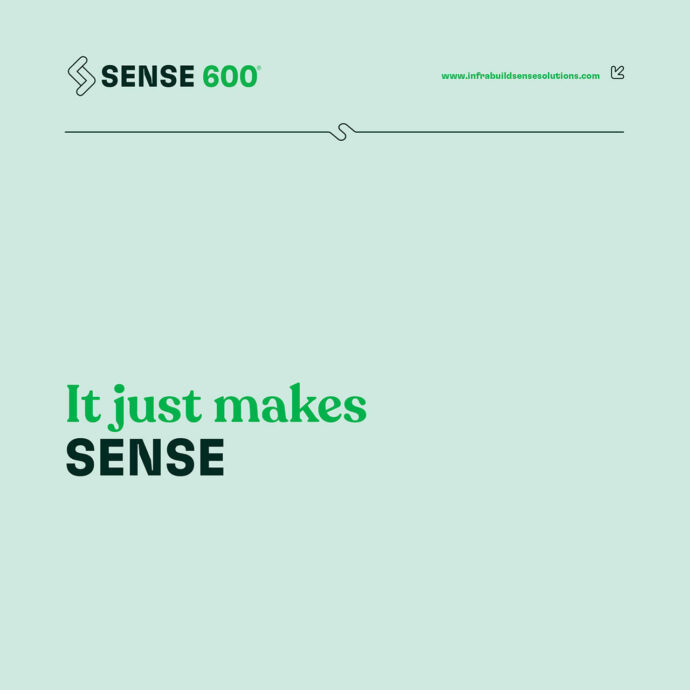
Infrabuild
SENSE 600: Innovative lower-embodied carbon reinforcing steel solution
InfraBuild’s SENSE600® high-strength reinforcing bar was first supplied in February 2024.
Utilising a unique 600N grade, InfraBuild took an innovative “equivalent load-capacity” approach, rolling SENSE600® in reduced diameters of 11-36.5mm (versus 500N at 12-40mm), whilst still delivering the same load capacity. This provides a 16.7% mass saving, meaning less scrap steel feed is needed, and less steel needs to be cast, rolled, transported and installed for the same structural outcome.
SENSE600® is recognised in relevant Australian Standards (manufacturing, concrete, bridge and foundation design), has unique bar patterns and line markings, third-party product certification, and is easily designed in using existing commercial design and sustainability software. It is supported by design guides, an EPD, and Type I Ecolabels (GECA, SSA).
Made solely from 100% scrap steel at InfraBuild’s EAF mills, SENSE600® reduces embodied carbon by up to 39% and reinforcing mass by up to 16.7% (compared to 500N).
SENSE600® improves material circularity because it is only made from scrap steel using EAF technology, thus eliminating BF-BOS billet. It has a recycled content of 97% (versus 82% for 500N) and a high material circularity indicator (MCI) value of 0.915 (versus 0.698 for 500N). SENSE600® also delivers significant reductions (30%-47%) in various LCI indicators.
One tonne of SENSE600® steel produces 20% more linear metres of reinforcing compared to 500N, increasing production and transport efficiencies.
Designing and supplying SENSE600® into Australian projects requires no additional time as it has been designed for like-for-like replacement of 500N.
New robotic tagging increases accuracy and uptime.
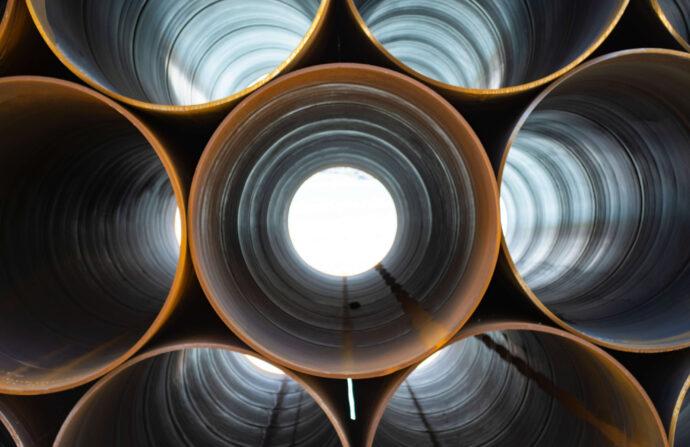
JFE Steel Corporation
Development of advanced sour resistant low-alloy steel for sour gas transportation pipes to contribute stable energy supplies
Natural gas is one of the clean energy sources with low CO2 emissions, and its demand is expected to rise. Raw natural gas can contain hydrogen sulphide, which may cause hydrogen embrittlement, specifically hydrogen-induced cracking (HIC), and sulphide stress cracking (SSC) in steel. Consequently, natural gas transport pipe steels with high resistance to hydrogen embrittlement are utilised. However, recent SSC accidents have occurred in low alloy steel pipelines transporting sour gas with high H2S concentrations. This has increased the need for low alloy steel for pipelines that offer even greater resistance to hydrogen embrittlement.
Specifically, the hardness of the outermost surface layer must be lower than before to improve SSC resistance. Additionally, it has become necessary to guarantee the hardness of the outermost surface layer of the steel plate for pipes through comprehensive inspection prior to installation. Furthermore, to enhance the safety of pipeline steel, it is essential to further reduce central segregation in the steel to improve HIC resistance. JFE Steel has succeeded in developing the world’s most advanced sour pipe-resistant steel for pipelines that meets all three of these requirements.
In the development of this steel, JFE first focused on creating “Outermost Surface Hardness Control Technology,” which achieves both high strength and low surface hardness in a low alloy design through advanced cooling control. JFE also developed the “Outermost Surface Hardness Full Inspection Technology,” which enables comprehensive quality assurance through our proprietary non-destructive inspection methods. This has improved sulphide stress cracking resistance in environments with high concentrations of H2S and contributed to stable manufacturing, including quality assurance during mass production.
Additionally, JFE have worked on developing a centre segregation control technology by optimising the position of soft reduction using a new sensor called a crater end metre during slab casting, which has led to improved HIC resistance. Moreover, JFE have optimised the heating conditions before rolling, resulting in a reduction of heat consumption by more than 10%. The yield of products has also improved by 11% due to stable HIC characteristics, and lead time has been reduced by 25% thanks to operational improvements in non-destructive inspection.
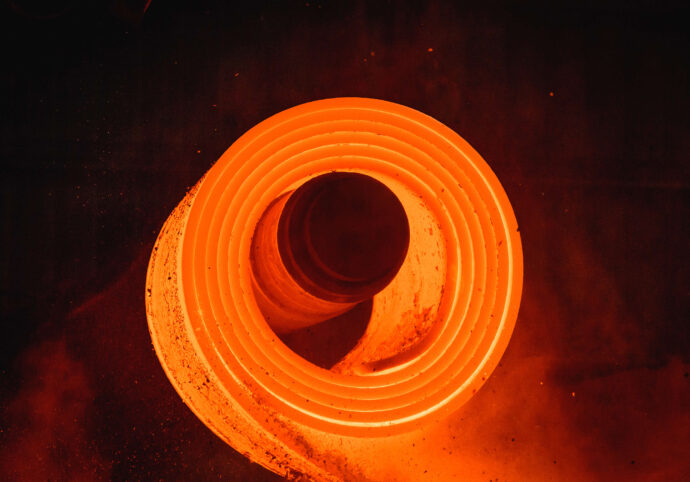
JFE Steel Corporation
J-Lecoa™: World-first integrated levelling control system for fully automated hot strip mill operation
In the hot rolling process, camber and wedge occur during rough rolling due to the asymmetric factor at the beginning of the rolling process, which induces meandering (off-centre) of the steel strip during the finishing rolling in the subsequent process.
As the meandering expands, a “tail pincher” problem occurs in which the tail end folds in. As a result, work roll replacement is required, which leads to a decrease in operating rate. Technology for stabilising strip threading (camber and meandering) during hot rolling is essential not only for improving operating rates, but also for achieving schedule free rolling and fully automated rolling to reduce CO2 emissions.
Conventionally, hot rolling leveling has been set manually by the operator through empirical judgment, but there has been a demand for DX (Digital Transformation) and CPS (Cyber Physical System) to achieve stable and automatic operation. Both camber and wedge control in the roughing mill and suppress off-centre in the finishing mill are key technologies to prevent tail pinchers.
A consistent automatic leveling control technology for rough and finishing mills that combines automatic rough leveling control and feedback leveling control (J-Lecoa™) was developed, and the combined effect has succeeded in halving the number of work roll changes caused by tail pincher troubles.
By reducing operating troubles, energy consumption (electricity, water and fuel gas) and CO2 emissions decreased, and the yield loss, lead-time operating ratio improved.
JFE Steel will continue to provide the world‘s best rolling technology for reduction of environmental impact, improvement of labour environment and productivity.
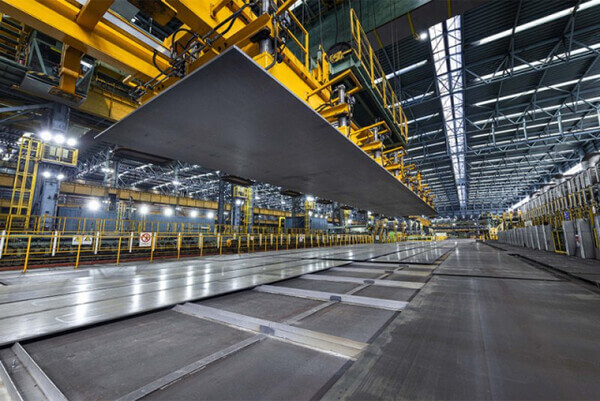
POSCO
Ni-free high manganese austenitic steel for cryogenic energy industries
High manganese austenitic steel is a ground-breaking innovation that redefines the standards of sustainable materials for cryogenic applications. Developed through proprietary technology, this product is the world’s first nickel-free austenitic steel specifically engineered for cryogenic use, emerging nearly a century after the advent of traditional austenitic stainless steels. By eliminating the need for costly nickel, we have not only reduced material cost but also addressed critical supply chain and environmental concerns.
High manganese steel achieves an unprecedented single-phase austenitic structure with a yield strength of 400 MPa—setting a new global benchmark for austenitic steels. Its exceptional strength enables significant thickness reduction, resulting in lighter structures, less material input, and faster construction timelines. These advantages directly contribute to minimising both direct and embedded carbon emissions throughout the product life cycle, supporting users in achieving their own sustainability goals.
Our innovation extends beyond alloy design. We pioneered a series of world-first manufacturing technologies, including molten ferromanganese production and advanced holding furnace systems, which enable stable mass production. The product’s unique property of requiring no heat treatment further streamlines manufacturing, reducing energy use and environmental impact. To ensure safety and reliability, the steel underwent rigorous validation; dozens of mock-up tanks were fabricated, subjected to comprehensive cryogenic testing, and deployed in multi-year field demonstrations on vessels and storage tanks. These efforts confirmed the technical excellence and operational performance of the high manganese steel. Recognizing its transformative potential, major international standards organizations—including ASTM, ISO, API, and the International Maritime Organization (IMO), one of the UN’s specialized agencies—have established new codes and standards for this material. The IMO’s first-ever registration of high manganese steel, along with the invitation to present at the 2024 plenary, underscores the product’s innovative technology and far-reaching global impact.
Currently utilised in large-scale ships and storage tanks, high manganese steel is accelerating the transition to eco-friendly fuels and setting a new paradigm for the steel industry, bringing the world closer to carbon neutrality.
Excellence in sustainability
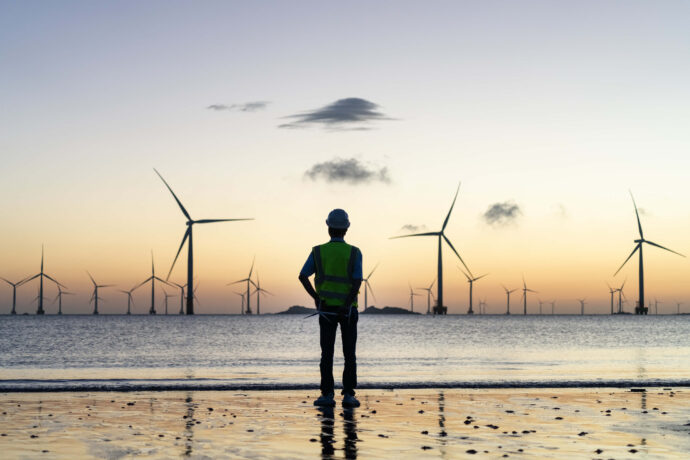
China Steel Corporation (CSC)
Zhong Neng offshore wind farm – Advancing a triple-win for the economy, environment, and society
Zhong Neng Offshore Project (ZNWP), an offshore wind farm co-developed by China Steel Corporation (CSC) and Copenhagen Infrastructure Partners (CIP), is Taiwan’s first landmark offshore wind project integrating local industrial capability with international capital.
With 31 turbines and a total installed capacity of 294.5 MW, the project received its electricity license in April 2025 and is expected to generate over 1.1 billion kWh annually— enough to power nearly 300,000 households and reduce CO2 emissions by around 550,000 tonnes per year.
Environmental monitoring throughout construction and operations—including air and water quality, noise, biodiversity, and underwater acoustics—confirmed full compliance with national standards, underscoring the project’s ecological responsibility.
Economically, China Steel Power Corporation (CSPC), is expected to generate NT$7 billion (equivalent US$229,462,800) in annual revenue and uses 11,000 tonnes of CSC-produced steel, promoting domestic low-carbon materials in green infrastructure. It also helps reduce Taiwan’s grid carbon intensity and indirectly lowers CSC’s Scope 2 emissions.
ZNWP has actively supported biodiversity and community engagement. Conducting 234 patrols and 259 monitoring efforts successfully protected the endangered Black-faced Spoonbill. It also backed the “Guarding the Sea of Our Homeland” marine education programme, which reached 3,481 students, and funded nine science camps through a local sustainability fund, benefiting 450 students and vulnerable groups.
ZNWP ensured regulatory compliance, risk management, and stakeholder transparency. An Environmental Monitoring Committee, comprising experts, NGOs, and residents, ensures accountability. The project also enforces ESG-based contracts and safety protocols with suppliers, maintaining a record of zero major safety incidents to date.

EMSTEEL
EMSTEEL’s suppliers’ ESG impact mapping and responsible sourcing framework
EMSTEEL has launched a pioneering in-house responsible sourcing and ESG supplier mapping programme to embed sustainability across its supply chain and advance its netzero and ESG strategy.
With upstream suppliers accounting for over 40% of Scope 3 emissions, the programme aims to assess, classify, and engage suppliers based on robust environmental, social, and governance (ESG) criteria.
Structured around a three-tier supplier model, the initiative is aligned with leading international standards such as ISO 14001, ISO 45001, CDP, ILO Conventions, CARES, and ResponsibleSteel™. ESG and Sustainability Assessments were made mandatory for Tier 1 suppliers in 2024 and Tier 2 in 2025, with Tier 3 integration planned for 2026.
The programme evaluates suppliers across nine ESG categories—including human rights, wellbeing, water and waste management, biodiversity, and GHG emissions—assigning ESG risk levels (high, medium, or low) to guide targeted engagement, improvement plans, and risk mitigation.
To build supplier capability, EMSTEEL has trained over 300 suppliers through ESG awareness sessions and Climate Fresk workshops focused on Scope 3 reduction for our supply chain function. Through partnership with DitchCarbon, suppliers gain access to tailored decarbonisation insights via a digital portal. High-performing suppliers are recognised through the Sustainability Leaders Recognition Program, while ESG audits of critical local suppliers began in 2025, with international audits planned.
This data-driven and collaborative programme has strengthened ESG integration in procurement, enhanced value chain transparency, and contributed to Scope 3 emissions reduction. It also elevated EMSTEEL’s CARES Responsible Sourcing certificate rating from “Pass” to “Very Good.”
In recognition of its impact, the initiative was awarded the “Procurement Sustainability Champion Award” in 2024, positioning EMSTEEL as a regional frontrunner in sustainable and responsible supply chain transformation.

Gerdau S.A.
Gerdau for Rio Grande do Sul: rebuilding the state after a climate tragedy
With 124 years of history and founded in Porto Alegre, the capital of Rio Grande do Sul—a state in southern Brazil—Gerdau is present in seven countries and employs approximately 30,000 people across all its operations. It is the largest Brazilian steel producer and one of the main suppliers of long steel in the Americas and specialty steel worldwide. It is also the largest scrap recycler in Latin America.
Throughout more than a century of existence, Gerdau’s activities have been guided by a commitment to the social development of the regions where it operates. Acting with social and environmental responsibility, based on a clear understanding of its role in society, is one of the company’s core principles. Not by chance, community engagement is a central topic in Gerdau’s materiality matrix.
Driven by the purpose of “empowering people who build the future,” the company seeks to cultivate impactful initiatives that create value for the communities where it operates, always with a focus on sustainability. One of the ten principles that guide Gerdau’s operations is generating value for everyone—embracing all those with whom the company interacts.
In 2024, Gerdau brought its purpose to life through actions that supported its home state in a critical moment. In May of that year, the state of Rio Grande do Sul, located in southern Brazil, was devastated by heavy rains. What began as an extreme weather event evolved into an unprecedented humanitarian crisis, affecting millions of people.
Faced with this urgent scenario, the company mobilised financial, human, and logistical resources to support the reconstruction of the state and its population. With investments of BRL 51.4 million (approximately US$8.6 million), directly benefiting thousands of people, Gerdau’s initiatives were structured around key pillars that ensured immediate relief and long-term solutions: social assistance, education, housing, infrastructure, and entrepreneurship. This amount represented nearly half of the company’s total social investment in 2024, which reached BRL 110.5 million (approximately US$19.77 million).

HBIS Group Co., Ltd.
Cross-utilisation of waste water and waste heat forming a new path for the deep integration of EAF process and urban development
The integration of steel and urban development has long been a contentious issue. In the current industry transformation, EAF faces greater challenges in integrating with cities compared to the blast furnace process due to its single-resource utilisation mode and poor quality of thermal resources.
Through the transformation practice of HBIS Shisteel Company, located in Jingxing mining area, from long process to EAF process with full-scrap 2 million tonne production, the project explores the cross-resource utilisation of wastewater and waste heat between the EAF process and the city, that is to say, using urban wastewater as cooling water for steel production, and the heat generated is fed back to urban residents for heating, which creates a new path of deep integration of EAF process and urban development.
By implementing integrated operation with wastewater treatment plants, the combined treatment of urban sewage and industrial wastewater provides cooling water for the EAF process. Creatively combining water source heat pump technology, the low-temperature waste heat (30-40°C) quality of the entire cooling water process is improved and used for urban heating. The water and heat that should have been released into the atmosphere are fully utilised, while effectively reducing the sewage discharge and the production of end concentrated saltwater production during the cooling process, supporting the realisation of the first electric furnace factory with zero discharge of concentrated saltwater resource utilisation wastewater.
The project has multiple benefits of water conservation, energy conservation, and carbon reduction, equivalent to saving 100.000 people’s water consumption every year, eliminating the impact of steel production on the urban water environment. It provides clean heat sources for more than 3 million square meters of urban residents, reducing carbon emissions by 100.000 tonnes per year. Through the dynamic circulation of water and heat between steel mills and cities, a harmonious coexistence is achieved between urban and industrial production.
The project provides a technical demonstration on how to coordinate the transformation of EAF processes in the steel industry with urban development, which has important reference value for the deep emission reduction and high-quality development of EAF processes worldwide.
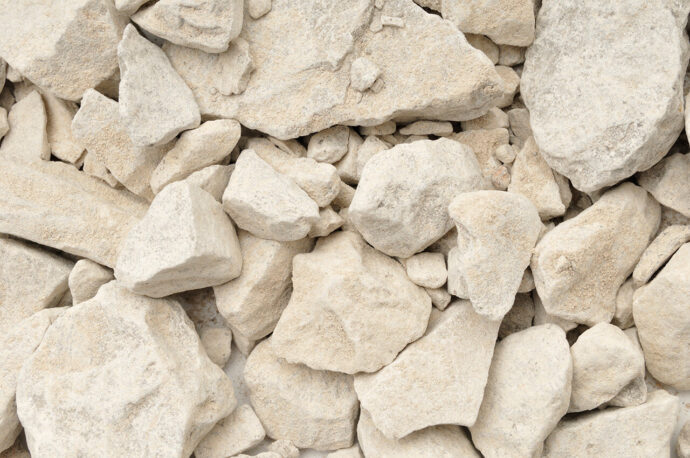
HYUNDAI Steel Company
Advancement of resource circulation using by- products between different industries
This submission introduces a sustainability project that combines two technologies: first, replacing fluorite, a supplementary material in the steelmaking process at Hyundai Steel, with sludge waste generated during the semiconductor process at Samsung; and second, replacing cement used in structural concrete with sodium bicarbonate dust, a steelmaking waste from Hyundai Steel.
The aim of this project is to minimise environmental impact and contribute to resource circulation through the resourcification of industrial co-products.
Most co-products generated in industrial settings are either disposed of or used for low-value or downcycled applications, causing environmental burdens and resource waste. The semiconductor and steel industries, in particular, generate a large amount of high-purity waste, along with growing requirements to convert it into high-value resources.
Korea is highly dependent on fluorite imports. In the case of cement, when raw limestone, the main ingredient of cement, is mined, it causes significant environmental damage, emitting a large amount of carbon. Korea is acknowledging the growing need for technologies that can replace fluorite and cement with domestically generated industrial waste.
This project aims to address challenges through a unified framework that integrates the following two technologies:
-
replacing fluorite with sludge generated during the semiconductor process at Samsung Electronics, and
-
replacing cement with sodium bicarbonate dust generated during the sintering process in steelworks.
These two technologies simultaneously achieve environmental and economic benefits by converting waste into high-value resources.
They are also regarded as a resource-circulating ESG initiative model, developed and implemented through cross-industry collaboration, and have demonstrated both commercial viability and sustainability by being applied in actual operational processes.
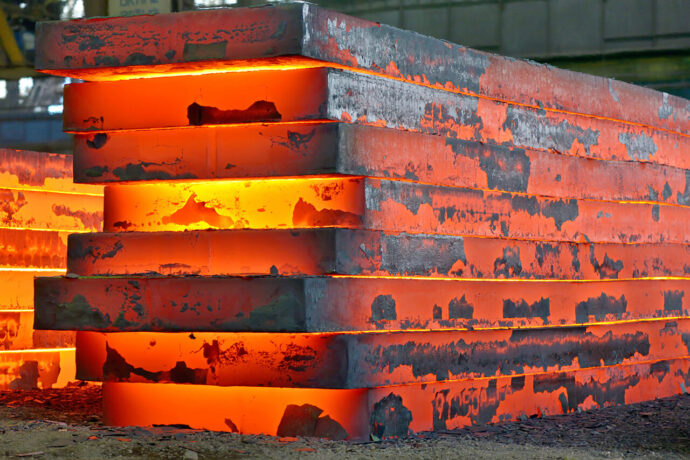
Mobarakeh Steel Company
Transforming industrial sludge into strategic value: A sustainability-driven innovation in steelmaking
In the current global shift toward carbon reduction and resource optimisation, industrial waste management has evolved from being merely an environmental obligation to becoming a strategic competitive advantage within the steel value chain.
Recognising this paradigm shift—and in alignment with its core philosophy of being “a responsible company for creating a better future”—Mobarakeh Steel Company (MSC) carried out a comprehensive identification and assessment of waste streams across its production chain. This assessment identified two high-priority waste types—hot rolling clarifier sludge and cold rolling acid pickling oxide powder.
MSC, in collaboration with an Iranian knowledge-based company, launched an Eco- Solution initiative to process 90,000 tonnes of hot-rolling sludge that had accumulated over the years, occupying valuable operational space and leading to environmental concerns such as oily leachate, unpleasant smells, and contamination of subsurface water resources. Additionally, they aimed to process 9,600 tonnes of acid pickling oxide powder containing 10% chloride, making it unsuitable for use in pelletizing processes. The high chloride content posed serious risks to equipment integrity and contributed to the release of airborne chloride particles, endangering both worker safety and the health of surrounding communities.
The project used advanced technologies and nanomaterial modifiers, avoided fresh water, and followed circular economy principles. Through a combination of physical, chemical, and technological treatments, the oily sludge and chloride-contaminated oxide powder (iron oxide) were transformed into:
- 69% iron concentrate
- chloride-free iron oxide powder suitable for industrial applications such as ceramics, pigments and magnetic parts
- valuable construction by-products such as bricks, blocks and pigments.
This scientifically engineered waste processing method not only reduces critical environmental risks but also creates measurable economic and social benefits, fully aligned with the United Nations Sustainable Development Goals (SDGs), specifically goals 6, 8, 9 11, 12, and 13.
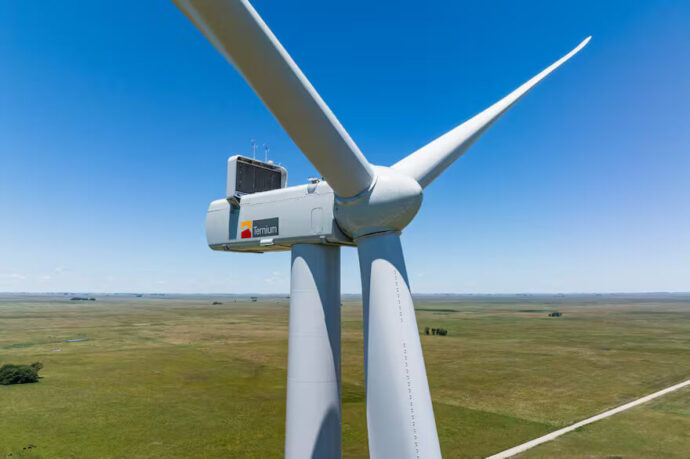
Ternium
Winds of change: Ternium’s first step into renewable energy in Argentina
Vientos Olavarría Wind Farm, featuring 22 wind turbines of 4.5 MW each and a total installed capacity of 99 megawatts, is Ternium’s first-owned large-scale renewable energy project. Fully operational since March 2025, it will generate approximately 480 GWh per year, enabling the replacement of nearly 90% of the electricity the company currently sources from the grid in Argentina. This will reduce CO2 emissions by around 111,000 tonnes per year.
Located in the city of Olavarría, Buenos Aires province—450 km from Ternium Argentina’s main operations—the site was selected for its strong wind potential, enabling a capacity factor of over 50%.
This project, developed entirely by Ternium’s internal engineering teams, marks the company’s first foray into renewable energy. It represents a milestone that showcases Ternium’s adaptability and strategic vision toward decarbonisation. With an investment of over 225 million dollars, its construction generated approximately 350 jobs, invigorating the local economy of Olavarría through the involvement of suppliers, technicians, institutions, and public organisations. It also promoted skilled employment, technical training, and cross-sector collaboration.
A comprehensive Environmental monitoring programme was implemented, including air and water quality testing, noise level assessments, and seasonal biodiversity surveys. No endangered species were identified, and bird and bat collision risks were deemed low. In terms of circular economy, the wind turbines contain 85% recyclable components.
Economically, the wind farm enhances Ternium’s energy cost efficiency and resilience. It provides significant savings and shields the company from market volatility and future carbon pricing. Ternium has also adopted an internal carbon price of US$80 per tonne of CO2 to guide investment in low-emission projects.
Socially, the project fostered inclusive development through community engagement, educational outreach, and technical training. Informative sessions were held with schools, neighbours, and institutions to promote awareness of renewable energy and environmental stewardship.
Excellence in Life Cycle Assessment

ArcelorMittal
Life Cycle Assessment being a vital part of AI-driven structural optimisation – Virtual Design Platform (VDP)
The Virtual Design Platform (VDP) integrates a robust LCA methodology aligned with EN 15978 and EN 15804 standards. Developed by ArcelorMittal as a Sketchup plugin, it is an optimisation and multicriteria ranking tool for the design of buildings considering carbon footprint, price and weight, on top of the structural performance.
The objective of the Virtual Design Platform (VDP) is to empower architects and engineers to make informed, sustainability-driven decisions during the early design phase. By integrating LCA into a generative design tool, the platform enables users to optimise structural systems based on environmental impact as climate change. The tool has successfully demonstrated its ability to reduce embodied carbon, improve material efficiency, and support compliance with sustainability regulations such as the European Green Deal.
After optimisation, the Virtual Design Platform (VDP) automatically generates a comprehensive Life Cycle Assessment (LCA) report that includes all mandatory
environmental indicators in accordance with the above mentioned standards EN 15804+A2. The assessment spans the full life cycle of the building, covering the product stage (A1–A3), transport (A4), end-of-life processes (C2, C3, and C4), and benefits or loads beyond the system boundary (Module D).
What makes this reporting particularly valuable is its clarity and accessibility: it presents complex environmental data in a format that is easy for engineers and architects to interpret. This empowers design teams to identify where in the building life cycle the most significant environmental impacts occur, and which building components offer the greatest potential for improvement. As a result, the VDP not only supports informed decision-making but also encourages iterative design refinement toward more sustainable outcomes — achieved quickly, in a matter of minutes.

CITIC PACIFIC Special Steel Group Co., Ltd.
Innovative practices in the development of low-carbon special steel products and brand building based on Life Cycle Assessment
Our objective at CITIC PACIFIC was to apply an LCA methodology to develop a comprehensive and credible framework for lthe market development of low-carbon products, and promote their practical implementation, thereby effectively addressing the current imbalance between low-carbon investment and output across the entire industrial chain.
Our approach involved collaborating with partners in the whole special steel industrial chain, including component manufacturers, OEMs, and owners, as well as LCA research institutions, associations, and relevant parties to jointly develop and promote.
The outcome finalised the development of representative new low-carbon products and
brand construction, thereby achieving enhanced user collaboration, business growth, market expansion, and eventually improving the business’s overall operational efficiency and profitability.

HBIS Group Co., Ltd.
“LCA+Life Well-Being Index” Collaborative Evaluation System: Innovating to drive marketing and application of metal decorative products
HBIS Group Dahe Metal Company has developed a new type of metal decorative products (coated steel-based), realising “replacing wood with steel” for the architectural decoration industry. However, the promotion of new metal decorative products in the decoration field faces problems: first, the advantages of their environmental performance lack quantitative evaluation, and customers have prejudices about whether steel materials are ”green”; second, the advantages of improving quality of life and the associated value to “people” have not been fully considered.
HBIS, in conjunction with international organisations, with the application of LCT as the core, has carried out a project on the “LCA+” evaluation methodology, tool development, and case study. Taking bathroom cabinets as a typical case, through a comparative analysis of “coated steel cabinets and particleboard cabinets,” the environmental performance and quality of life improvement value of the two schemes under different service lives are studied. The results show that coated steel cabinets have significant advantages in reducing environmental load and improving quality of life, and the longer the service life, the more obvious the advantages. The project team has formed an evaluation tool and a solution that can quantify environmental performance and intuitively present the value of improving quality of life, achieving a breakthrough from “quantitative presentation of environmental data” to “concrete perception of life value”. The project is undergoing professional review by the third-party thinkstep-anz .
This case also led to orders for bathroom cabinets in the renovation of Shijiazhuang Yanshan Hotel and for the redecoration of the library at Suzhou Campus, Nanjing University with Dahe Metal Company, successfully transforming LCA data into market competitiveness. The “LCA+” solution was also officially released at the 2025 World Steel Association LCA Conference, providing a scientific and practical demonstration sample for the large-scale implementation of metal decorative products in the architectural decoration field.
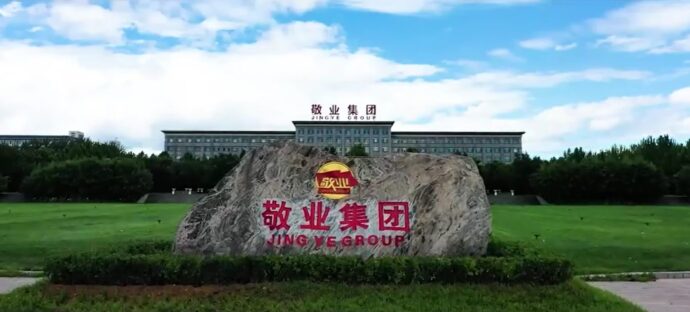
Jingye Group
Research and application of metal powder PCR based on steel joint
production
This project, led by Jingye Group, created an integrated production scenario combining
steel and metal powder industrial chains. In collaboration with upstream and downstream partners, research institutions, and third-party verification agencies, it conducted LCA methodology research for metal powder products and developed publicly released PCR for metal powders. Based on the PCR documentation, Jingye Group successfully released the world’s first EPD for iron-based metal powders, validating the LCA pathway for reducing environmental impact through steel integration. The verification results were used to optimise the project’s energy structure and overall layout, continuously improving product environmental performance.
Metal powders are fundamental to advanced manufacturing, essential for everyday products like mobile phones, automobiles, TVs, and laptops. Approximately 70% ofautomotive components can be manufactured through powder metallurgy. Under
traditional processes, each tonne of metal powder product generates about 30 tonnes of carbon emissions with significant environmental impact, yet product LCA accountingmethodologies were previously non-existent. The steel industry’s supply chain can fully cover all raw materials and fuels for metal powder/3D printing production lines, and steel companies’ robust environmental protection systems enable perfect recycling of wastewater, exhaust gas, and solid waste from metal powder/3D printing production. Verification shows that integrating steel and metal powder industrial chains can reduce the environmental impact of metal powder products by approximately 66%.
The combination of green low-carbon development in the steel industry with the high added value of metal powder products presents a breakthrough path for the steel industry.
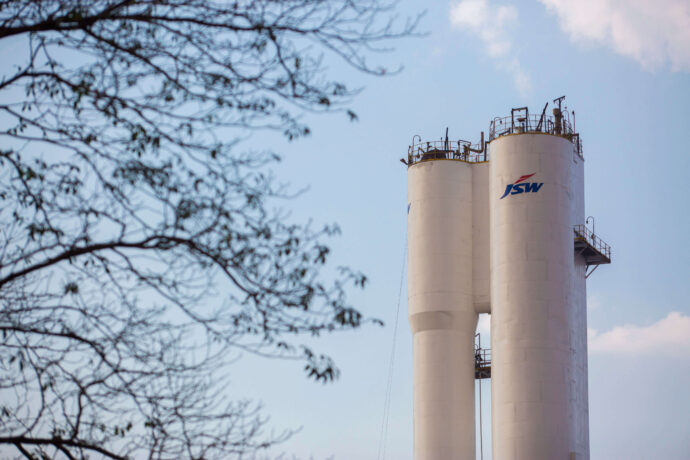
JSW Steel Limited
Use of LCA tool to predict the impact of green hydrogen manufacturing process and its injection in gas-based DRI plant under various scenarios
JSW’s objective was to develop a denmonstration project for a new green hydrogen
manufacturing facility and use the green hydrogen produced for injection in an existing DRI plant.
The project is powered by renewable electricity sourced from a combined 825 MW portfolio of wind (600 MW) and solar (225 MW) assets owned by JSW Renewable Energy. A dedicated transmission line ensures continuous, round-the-clock supply of this green power to the hydrogen plant at the JSW Vijayanagar complex.
The green hydrogen plant uses a 25 MW alkaline electrolysis system to convert demineralised water into hydrogen and oxygen, powered entirely by the dedicated renewable electricity. The project activity consists of two phases. In the first phase, which is currently implemented, the facility will supply 5000 NM3/hr of green hyrdrogen and is equipped with advanced electrolysers featuring dedicated rectifiers and transformers, and all necessary utilities are supplied on-site to support smooth operations. For phase two, planned in future this existing facility will be ramped up to supply 20,000NM3/hr of green hydrogen.
Produced green hydrogen is delivered through a dedicated pipeline to the DRI plant at
Vijayanagar. The existing DRI plant of 1.2 MTPA (million tonnes per annum) capacity operates with gas generated by the Corex plant at JSW Vijaynagar works.
The LCA study has been used to predict impacts under various potential scenarios which will assist the plant operations to take decision for process optimisation.
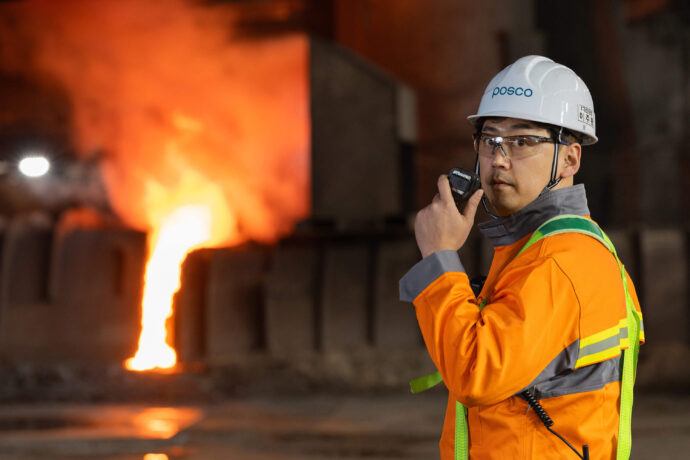
POSCO
CEFacT: A system that responds to steel industry decarbonisation standards
In response to the global low-carbon economy and the resulting industry paradigm shift, this project has developed a system to monitor the CO2 emitted by each steel product. First, a method has been devised to assign grades to carbon-reduced steel products; then, a staggered costing scheme will be determined, based on the steel industry’s LCA concept.
By combining this CO2 emission tracking with the cost analysis tool previously developed by POSCO, the system assesses the PCF of steel products by various production methods and routes. Because this system is flexible, composed of a clear emission profile and cost of each steel product, the transparent findings can be readily shared with customers. The system is designed to estimate CO2 emissions throughout the manufacturing process, from raw materials procurement to final product. Collected at daily and monthly intervals, the estimation method subscribes to the principles of mass and heat balance, which comply with ISO 14044 and 14067 standards.
Based on a top-down approach, a steelworks is split into plant unit and then product unit by defined boundaries, where CO2 emission intensities and CO2 emissions per unit, were estimated. The CO2 emission intensity was used to determine the CO2 emissions along production routes of products. The monthly estimated CO2 emissions were 99.7% consistent with the confirmed CO2 emissions of the steelworks. Depending on environmental policy and regulations, the CO2 emissions of scope3 from the upstream supply chain was partially added.
The goal of this project is to perform daily and/or monthly management of the CO2 emissions of each steel product. As a result, customers are informed about the carbon footprint of their products before they are shipped to them. Additionally, when this
forecasting and tracking system combines with the cost analysis tool, a tangible pathway can be offered to achieve decarbonisation in the steel industry.
Excellence in people
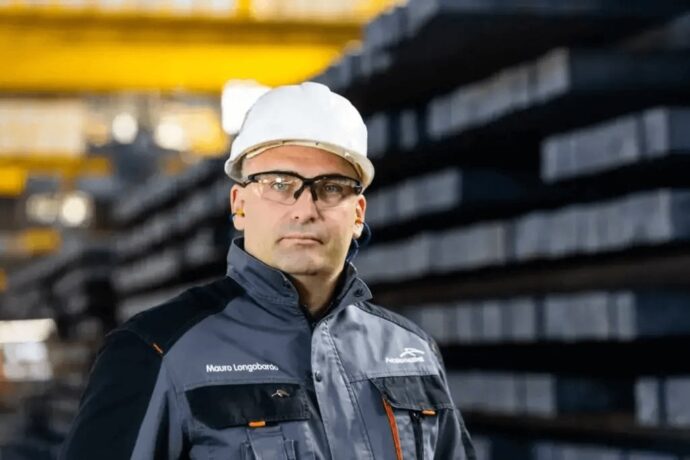
ArcelorMittal
Integration of army veterans and supporting the families of fallen employees
ArcelorMittal Kryvyi Rih, located just 80km from the frontline of the war in Ukraine is facing a labour shortage. This is a long-term trend caused by demographic decline, but which has of course become very acute because of war. The number of employees has decreased from 27,000 in 2021 to 18,000 in 2025, a 33% decline.
The plant has reduced production capacity and optimised some production processes, but due to the severe outflow of the workforce, there are currently over 1,000 vacancies. The staffing level is only 85% of the required staff, which creates risks for the stability of operational activities and the implementation of production plans. Currently 3,056 of ArcelorMittal’s Ukrainian employees have been mobilised, of which 66% have more than 8 years of work experience in the company. Of the more than 3,000 employees, 39% are production personnel, 48% are maintenance personnel, 9% are distribution/transportation personnel and 4% are support staff.
In response to this challenge, the company has created an ecosystem for veteran reintegration, which provides conditions for the gradual return of mobilised employees. 620 veterans have returned from the Armed Forces, 258 of whom have already resumed work. Four important focus areas have been identified for their smooth return:1) the establishment of a coordination centre 2) reducing bureaucracy within the framework of Ukrainian legislation 3) creating inclusive workplaces and 4) easy and accessible physical rehabilitation.
Tragically, ArcelorMittal Ukraine has also lost 224 employees who were killed. Another 78 are missing and 7 are in captivity.
As a responsible employer, ArcelorMittal has provided more than UAH 116 million (2.7m USD) to support the families of its fallen, missing, and captured employees, demonstrating social responsibility and further strengthening its reputation among the public, partners and customers. ArcelorMittal has created an ecosystem of communication, mutual support and care to keep in touch with the families of our deceased colleagues to ease their psychological burden and ensure that they continue to have an active social life in contact with the company.

China Steel Corporation (CSC)
Next-generation operational training and process assistance system through digital twin technology
This project applies Digital Twin and Extended Reality (XR) technologies to enhance training and operational support in high-risk, labour-intensive 3K industrial environments—those defined by dirty, dangerous, and demanding conditions. By developing immersive, realistic, and scenario-based virtual training environments—such as converter tapping, defensive driving, hot work coordination, and crane remote operations—workers are able to repeatedly practice critical procedures without exposure to real-world hazards. This approach greatly enhances their technical proficiency while also supporting the structured transfer of experiential knowledge from senior operators to newer personnel.
To extend its value beyond training, the project integrates Internet of Things (IoT) devices and 5G communication to establish a real-time digital assistant platform. This platform facilitates seamless remote expert collaboration, equipment monitoring, personnel guidance, and digital walkthroughs. The system overcomes traditional spatial and resource limitations by enabling remote access to live process data and supporting timely decision making across dispersed teams.
The project also incorporates Artificial Intelligence (AI) and physics-based simulations to build virtual-physical synchronised models of complex steelmaking processes, such as converter tapping and blast furnace burden distribution. These models support predictive analysis, operational optimisation, and digital verification of new process designs. Future development includes the application of reinforcement learning, enabling the system to evolve and optimise its decision making autonomously.
Looking forward, the platform is expected to expand into advanced applications, including autonomous vehicle coordination and remote centralised control, laying the foundation for highly efficient, low-emission, and intelligent manufacturing ecosystems. By combining connectivity, simulation, intelligence, and immersive training, this project represents a transformative step toward the digital future of the steel industry.
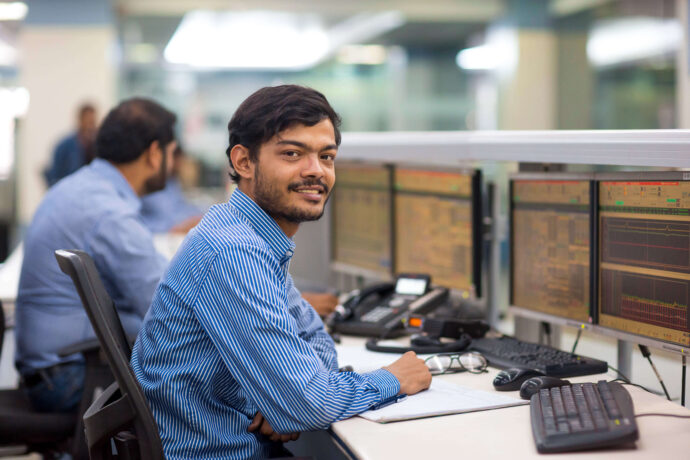
JSW Steel Limited
JSW Steel’s strategic framework for scaling steel technical expertise and innovation
JSW Steel’s Skill Development Ecosystem has established a strong foundation for building technical expertise that supports the company’s rapid growth and technological evolution. At the heart of this ecosystem lies the JSW Technical Competency Framework, which serves as the foundation for all initiatives. This framework operates in a continuous cycle: Technical Talent Identification, Technical Skill Development, and Continuous Learning. This approach ensures the workforce stays equipped with the latest capabilities needed in advanced areas like Industry 4.0 and 5.0.
The journey begins with the JSW Technical Leaders Program, launched in 2022, which identifies high-potential experts who lead key projects, delivering significant
improvements and cost savings. In just two years, over 36 projects have already delivered significant business impact, including potential annual savings of INR 361 crore (40.7m USD).
Employees engage with the JSW Technical Academy, a digital learning platform developed with steeluniversity. Covering 13 steel-specific job families, it offers courses aligned with different proficiency levels—from execution to management, offering self-paced, interactive courses that fit diverse learning needs through interactive modules, 3D simulations, and certification programmes. To promote continuous learning, JSW launched the Skills Assessment Development Program, integrating assessments and individual feedback into the learning journey. A new Self-Assessment Platform is being developed in partnership with steeluniversity to help employees track progress and identify skill gaps for scalability purposes.
With over 12,000 technical employees, JSW’s framework ensures a future-ready workforce. By combining rigorous assessment, targeted learning, and defined career paths, the system fosters a high-performance, agile culture. This strategic approach not only supports JSW’s exponential growth goals but also sets a new industry benchmark in technical capability and innovation.

POSCO
TL advancement: The key to a sustainable workforce and enduring expertise
Our TL programme divides production workers’ capabilities into five distinct levels, each representing a stage of professional growth. At every level, employees are encouraged to develop competencies across three main categories: 1) individual job skills enhancement, 2) transfer of technical knowledge and expertise, and 3) work practice innovation. As employees progress through the levels, the depth and complexity of these competencies escalate to guide incremental development.
Within this leveled framework, employees engage in distinctive activities that drive both personal and organisational advancement. For those in the early TL stages (1-2), the focus is on building core individual job skills through structured and self-directed learning. Programmes include on-the-job-training (OJT), a combination of online learning and offline instruction, a.k.a. “blended learning”, and close mentoring. This immersive learning environment speeds up their assimilation to the work process, facilitating the acquisition of essential skills.
As employees progress to the mid-level TL(3), they move beyond foundational skills to target professional growth, such as through patent applications, acquisition of professional certification, and participation in advanced projects. These activities help to add depth to their expertise and to contemplate ways to seek innovation in work practices. At the most advanced TL stages (4-5), senior employees are encouraged to formalise their tacit knowledge. To do so, they compile manuals, perform training, and provide technical guidance on seminal projects. Their stewardship ensures the systematic transfer of key knowhow to the next generation, strengthening the company’s resilience in the face of workforce challenges, such as mass retirement and the ongoing need to hire new talent.
Through this phased and guided advancement programme, the TL system ensures that individual growth is linked to tangible business outcomes and becomes a core driver of sustained industry excellence through a virtuous cycle of knowledge sharing and mentoring. With 87% of our workforce benefiting, 700+ patent applications, and 2,200 certifications, the TL system is poised to set a new industry standard and serve as a leading model for workforce excellence in the steel industry.

Tata Steel Limited
Forging futures: Skilled hands, strong minds, safer tomorrow
Over a century ago, Tata Steel’s visionaries established a technical training institute, SNTI, to create a strong technical bench strength for the company, and the nation at large. Today, several corporate leaders are proud alumni of this institute. In the past few years, contract employees have become a fluid part of the workforce across operations, maintenance, mining and construction areas. It was imperative to right-skill people – mostly illiterate / semi-literate – in this segment for a safe and productive workplace. In 2019, Tata Steel took the first steps to embark on this transformative journey of right skilling this segment of the workforce despite the challenge of a very high turnaround of contract employees. The skilling efforts of Tata Steel have helped them acquire a ‘skill passport’ enabling gainful employment across industries.
The initial period was largely spent continually assessing/certifying (silver/gold/platinum) the existing proficiency levels of people (~100,000 annually) for eligibility to work at any of the Tata Steel sites. Since the later part of 2023, efforts have been directed at ensuring that every high hazard job area had people certified as gold or platinum thereby necessitating training of the contract workforce. Multi-site operations cutting across four states, varied degree of literacy levels, and language barriers were challenges to address in ensuring effective training necessary for a safe and productive workplace focused on quality of outcomes. In 2025, to address these challenges several innovative solutions were conceptualised and rolled out to ensure that the skilling effort was transparent and scalable across the geographical dispersion, while addressing customised language preference for effective learning. Digital solutions coupled with continuous on-job evaluation was enabled to train and certify people across multiple skill trades. The effort has resulted in high employee engagement contributing to operational excellence and high productivity while creating a safe workplace.

Ternium
From policy to practice: Advancing inclusion across Ternium’s industrial system
At Ternium, a leading industrial player in the Americas, we have experienced exponential growth—evolving from a regional manufacturer to a multinational group through strategic acquisitions, complex integrations, and continuous industrial expansion. Our workforce grew from 16,700 employees in 2015 to over 21,500 in 2025, with an additional 12,500 people joining from USIMINAS, operating across more than 10 countries, cultures, and diverse realities.
We recognize that 74% of the Sustainable Development Goals (SDGs) depend directly or significantly on achieving gender equality, and that embracing diversity in all its forms—gender, sexual orientation, generations, nationality, ethnic-racial identity, disability, and more—is key to building a strong industrial culture, fostering well-being and engagement, and maximising operational performance. This leap demanded a profound transformation in our people strategy. That’s why we created a dedicated Organizational Development area, with a clear goal to lead our Diversity, Equity, and Inclusion (DEI) strategy across all levels of the company. From there, we launched our first Diversity and Work Environment Free of Harassment Policy, taking a clear stand from leadership and laying the groundwork for structural cultural change.
But we didn’t stop at policy.
We began a journey of integral transformation—progressively aligning the entire employee lifecycle with DEI principles: from talent attraction to offboarding, development, leadership, and performance processes. This inclusive lens has also extended to our value chain, the communities where we operate, and to the paradigms that have historically limited the industry.
Today, inclusion is no longer a standalone initiative—it is embedded in how we operate, how we lead, and how we grow.
Excellence in communications programmes
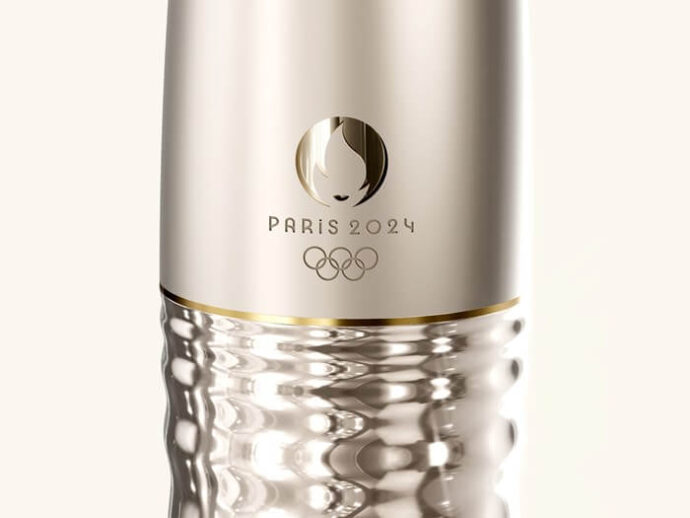
ArcelorMittal
The Paris 2024 Olympic and Paralympic Games
ArcelorMittal was proud to serve as an Official Partner of the Paris 2024 Olympic and Paralympic Games, playing a key role in the manufacture of the Olympic torches and the ‘Spectaculars’ (the Olympic Rings and Paralympic Agitos) that were installed on the Eiffel Tower and Arc de Triomphe.
In collaboration with torch designer Mathieu Lehanneur, Paris 2024 President Tony
Estanguet, and other creative and technical experts, these iconic symbols were brought to life at our sites in Châteauneuf, Florange, and Woippy. Manufacturing was done using ArcelorMittal’s XCarb® recycled and renewably produced steel, contributing to Paris 2024’s realised ambition to become the most sustainable Olympic Games on record.
Our journey with Paris 2024 was one of partnership and shared values. The ambitious design, manufacturing and delivery brought together designers, architects, engineers, and visionaries to create something extraordinary.
A collaboration between the ArcelorMittal France team on the ground in Paris and the Corporate Communications team, the campaign combined communication efforts
throughout the Games, ensuring maximum visibility, coverage and engagement with the ArcelorMittal partnership, our steels, and our unique contribution among sponsors. Campaign activity blended internal and external communications across multiple channels and audiences including print, website, social media, experiential advertising, video, events, press trips and more. The strategic, creative mix of original content and authentic storytelling helped to reflect the brand’s commitment to sustainability and innovation, while showcasing the influential, yet often overlooked, role steel plays in cultural and connected activity.
The result was record-breaking media coverage and employee engagement, building momentum from the torch relay all the way through to the Olympic and Paralympic Games in Paris.
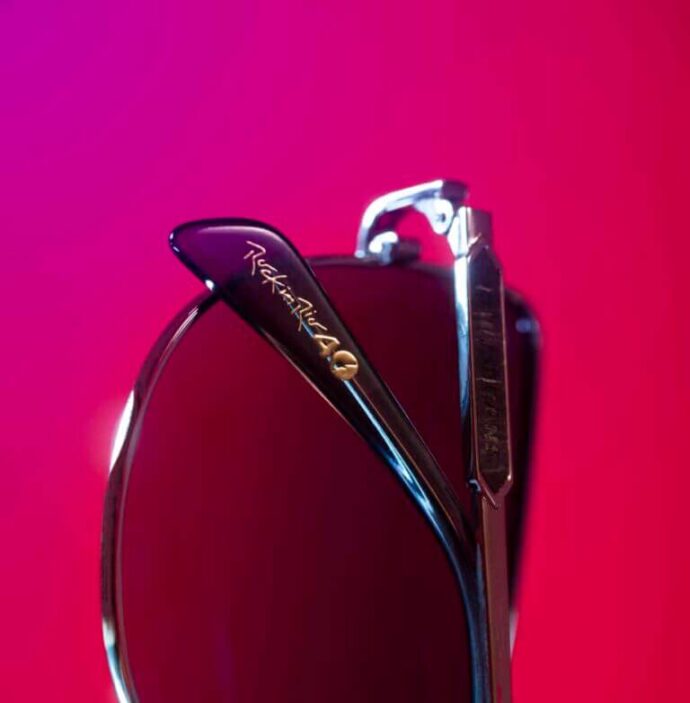
Gerdau S.A.
Steel is POP: The steel sunglasses that united Gerdau and Chilli Beans at Rock in Rio
With its products, Gerdau is present in people’s daily lives around the world: in the homes they live in, the offices they work in, and the bridges, highways, and overpasses they cross every day. However, as a B2B company, its operations are not very tangible to the general public, who often don’t realise how steel is part of their lives every day.
Despite investing in innovative initiatives and striving to bring steel closer to the public, the steel production sector still faced the challenge of overcoming the negative image
historically associated with mining and steelmaking in Brazil.
Faced with this scenario, Gerdau realised it needed to humanise steel and bring it closer to society — to make it visible, relatable, wearable. Steel is in almost everything, yet it goes unnoticed. As a centennial brand, Gerdau needed to modernise and connect with new generations, showing how tradition, sustainability, and innovation can walk together toward the future.
In 2022, Gerdau became a sponsor of Rock in Rio, the world’s largest music and entertainment festival. More than just sponsoring the event, Gerdau made steel one of its protagonists. With a bold strategy, a new “World Stage” was launched — the largest in the festival’s history — built entirely from 100% Gerdau recyclable steel.
The desire to get even closer to the public sparked the idea of a collaboration with Chilli Beans to create sunglasses made of steel — a tribute to the Rock in Rio’s (World Stage), which features over 200 tonnes of 100% recyclable Gerdau steel in its set design. The sunglasses line became a fashion product, a symbol of attitude and youth, carrying the same DNA of innovation and sustainability that drives Gerdau.
More than just creating a desirable item, the partnership between Gerdau and Chilli Beans was designed to showcase how steel is part of people’s everyday lives. The material that builds cities now also shapes a fashion accessory. The inspiration came from the stage’s scenography — an 860 m² structure, equivalent to a 10-storey building.
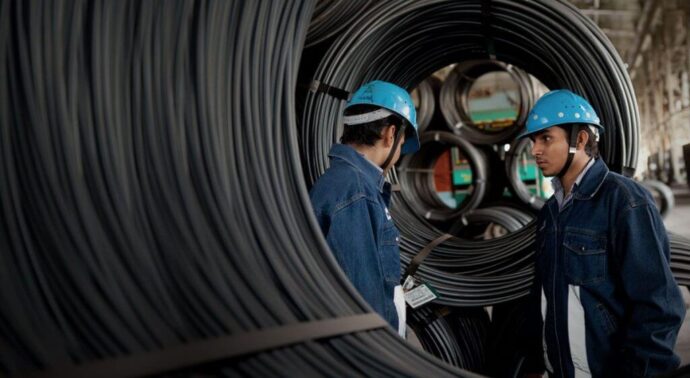
JSW Steel Limited
JSW Steel MSME Empowerment
India’s extraordinary growth is driven by the millions of MSMEs across the nation, whose innovation, resilience, and entrepreneurial spirit are propelling the country forward. These businesses see opportunities where others see challenges. They think differently, dream bigger, and are constantly reimagining industries and reshaping the economy.
At JSW Steel, we recognise the power of this transformative force. That’s why we introduced JSW Steel for MSME: MSMEs – Initiatives by JSW Steel—a set of programmes designed to simplify procurement and make the raw materials MSMEs need more accessible than ever, enabling them to focus on what they do best: innovate, grow, and drive change.
On MSME Day (27 June 2024), we set out to capture the spirit of MSMEs—fueled by innovation and imagination—through a film that brings their story to life with hand-drawn illustrations. Each frame of the video tells the story of how MSMEs are not just surviving but thriving—dreaming beyond limits, redefining industries, breaking boundaries, and building the future of India.
The success of this spirit was reflected in the campaign’s performance, achieving an
impressive 41.06 million total views, with 36 million views on Instagram alone and an engagement rate of 65.61%.
This film is a tribute to the power of MSMEs, showcasing how they are shaping India’s growth while highlighting how JSW Steel is empowering them to build, visualise, and achieve their potential.

Tenaris
Safety in First Person
Safety in First Person is a video series adapted into eight languages, designed to highlight lessons learned from specific incidents or accidents within our operations at Tenaris. These are real events explained by our own people, directly from the field, who share not only what happened, but also their insights and reflections.
To create a stronger connection and make the message more impactful, we chose to film these videos using a POV (point of view) format—placing the viewer in the middle of the scene, as if they were experiencing the event firsthand. This immersive approach helps recreate the context in a more engaging and realistic way, making it easier for employees to relate, understand the risks involved, and connect with the people behind the stories.
By seeing the event unfold through the eyes of those key referents from the area where it occurred, viewers are encouraged to reflect, speak up, and apply the lessons learned in their own daily work. This initiative fosters safety conversations and promotes a stronger, more personal commitment to prevention.
The series is shared by our Global Senior Director of Health and Safety through an email campaign sent to all mill employees and other internal channels, such as TenarisToday (our intranet), TV screens and WhatsApp. The main goal is for them to watch it and to cascade and discuss the video with their teams.
This production is part of the Safety Update campaign, an ongoing weekly communication also sent by our Health and Safety Senior Director to all employees. Each weekly message includes a detailed infographic featuring information about accidents or incidents that have occurred at Tenaris mills across the regions where the company is present.

Tenaris
Tenaris Siderca 70th anniversary
To commemorate the 70th anniversary of TenarisSiderca, Tenaris’s Industrial Center in
Campana, Argentina, we developed a multichannel campaign with different actions
and initiatives to reflect the mutual growth between the company and its community.
One of these actions was the production of a video portraying daily life in the city and the mill, emphasizing the company’s strong ties with the community. This piece was the cornerstone of an internal and broader media campaign.
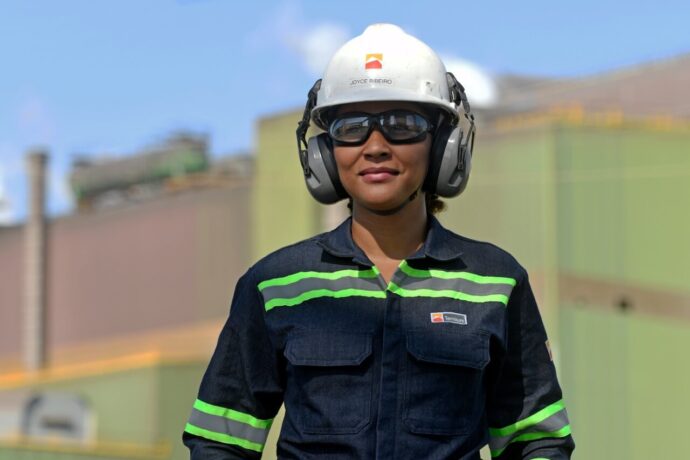
Ternium
“Tomorrow, Santa Cruz” Documentary – Building Futures Through Education
“Tomorrow, Santa Cruz” is a documentary strategically produced by Ternium Brazil to
showcase the construction of the newest Roberto Rocca Technical School—the first in Brazil and the third within the Techint Group network. This short film serves as an initial step in highlighting the creation of the school, which will welcome students from the neighbourhoods of Paciência, Sepetiba, Itaguaí, and Santa Cruz (Rio de Janeiro).
By 2027, the Roberto Rocca Technical School is expected to accommodate 576 students from these communities. This initiative reflects one of the Techint Group’s core values: fostering development and inclusive growth in the regions where it operates. To bring these values to life, the documentary follows the journey of local students transitioning from under-resourced public schools to a high standard institution, where they face new academic challenges and opportunities for personal transformation.
Through their stories, these young students take centre stage, sharing their aspirations and their belief that education can change their futures. Their testimonies illustrate how Ternium, through community-focused initiatives, fulfills one of the Techint Group’s most important commitments: advancing technical education as a catalyst for growth, transformation, and social mobility.
The film also highlights the people behind the project—the professionals building the
school, future teaching staff, and Ternium Brasil’s technical team—whose perspectives underscore the deep and lasting impact the Roberto Rocca School will have on Santa Cruz, creating real opportunities for local development.
Producing a documentary was a deliberate strategy to reinforce Ternium’s commitment to the region—not only by showcasing its most significant investment locally but also by ensuring the community could directly access the story. To achieve this, the film premiered on TV Band Rio, a major free-to-air channel reaching 92 municipalities and an estimated 3 million viewers across Rio de Janeiro. Additionally, over 2,000 people—including teachers, students, Ternium employees, and staff from other Techint Group companies— attended local screenings. The documentary is also available on the official TV Band Rio YouTube channel, ensuring broader access.
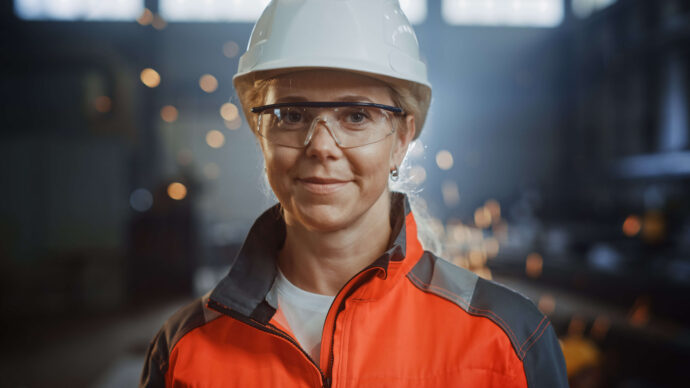
UNESID
#WomenOfSteel (#MujeresDeAcero)
#WomenOfSteel (#MujeresDeAcero) is a long-standing communication initiative launched in 2015 by UNESID to raise visibility and recognition of women in Spain’s steel industry. Over the years, it has evolved into a multi-format programme that highlights the contribution of women across the sector—from production to leadership— while promoting inclusion and diversity.
In 2022, the initiative gained new momentum with the launch of annual webinars, each year focusing on a different topic and bringing together female professionals from various steel companies. These virtual events provide a platform for participants to share their career experiences, personal reflections, and challenges, building a community of supportand inspiration within the industry.
The latest milestone of the campaign has been the relaunch of the #WomenInSteel website in March 2025, improving its usability, accessibility and content structure, where you can find all the information related to gender equality actions in the sector with data, news and individual and collective programmes of the steel sector to be a reference in the best way to its growing audience. The updated site offers clearer navigation, fresh interviews, and an improved multimedia experience. #MujeresDeAcero’s goal is not only to strengthen the internal reputation of the sector among employees, but also to showcase steel as a modern and inclusive industry to the broader public.
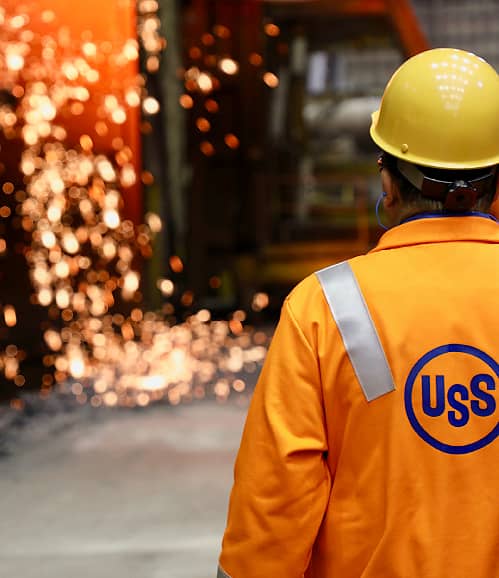
United States Steel Corporation
I Live Here, Too
U. S. Steel’s environmental team works every day to ensure that compay facilities adhere to rigorous environmental standards. They do this work in an adversarial, and often hostile, atmosphere where the constant scrutiny of regulators, environmental groups, and activist media outlets makes a difficult job even harder. This project sought to tell the stories of the men and women whose jobs address environmental compliance at our facilities each day. For them, a commitment to environmental excellence isn’t merely professional, it’s personal. Why? They live in the communities where they work and want clean air, clean water, and a clean environment for themselves and their families. The reason is simple, and it’s what we called this programme: “I Live Here, Too.”
Finding the right employees to tell their stories was crucial. We chose our stars because of their professional acumen, their ties to the communities where they work, their commitment to innovation, and, where possible, a family history in the region. The videos were not scripted and the employees answered questions from a producer standing off camera. The only scripted portions were their introductions, and the “I Live Here, Too” that tied their portion to the rest of the campaign. The final product made for a genuine, heartfelt, and compelling message why U. S. Steel’s drive for environmental excellence is one of the cornerstones of company culture.
U. S. Steel produced six videos targeted toward geographic areas where our message was needed most. Phase one involved the first four videos and featured U. S. Steel employees from the Monongahela Valley surrounding company facilities in the Pittsburgh, PA area. The final two videos starred employees working at the U. S. Steel facility located in Gary, IN, a short distance from Chicago. Videos were targeted to the Pittsburgh and Chicago areas via social media and Google advertising.
The videos were posted to U. S. Steel’s website, Facebook, LinkedIn, and X feeds as well as the X-App, an internal facing news source for employees enterprise wide. Each video lasted one minute or less, thirty-second versions were also created to be used as television advertisements. The videos were deployed over a six week period, with one video being released each week. Prior to launch, a “trailer” video was created for X-App to create some interest among U. S. Steel employees.
